|
 |
| Introduction. The project 180º |
The first post office in the Faroe Islands was opened in the capital, Tórshavn, on March 1st 1870. Until April 1st 1976 the postal service in the archipelago was under the direction of the Danish Post, Post Danmark.
After that date, the autonomous government of the Faroe took over the postal service and created a new public institution named Postverk Føroya.
From 2005 Postverk Føroya is no more a state-owned company, but a private enterprise with a network of about 30 post offices and 300 employees, serving a population of about 50,000 inhabitants. |
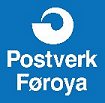 |
As a result of this transformation to a private company, and taking into account the recession of the postal market, Postverk Føroya launched in January 1st 2008 the Project 180º, a radical change in the company, which aims to modernize and meets much better to the postal customer needs. The project will develop in the next coming years, and includes some main guidelines that take into account the particular situation of postal users in the Faroe Islands. Among them, and related to our study field, Postverk Føroya plans to install postal kiosks in post offices and commercial centers, and also the opening of small postal outlets in commercial establishments, some of them fitted with variable value stamp printers.
We'll follow this interesting project in future articles.
| The PostSelv postal kiosks |
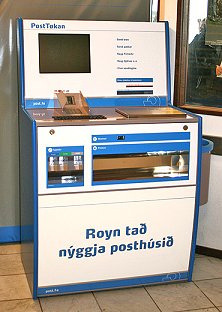 |
Following the experience of Post Danmark, also Postverk Føroya decided the installation of the PostSelv postal kiosks manufactured by the Danish company aCon.
These self-service postal kiosks have similar characteristics to those already in service in Denmark (see article) and Norway (see article), although they are customized according to the Postverk Føroya company markings and corporative color. The texts are in Faeroese, the official language of the Faroe Islands: The PostSelv are called here PostTøkan, or the invitation on the front of the kiosk, Royn tað nýggja posthúsið, which could be translated as 'Try the new post office'.
Following the steps indicated in the touch screen, and using the scale, the customer can obtain the franking for the letter or parcel, or buy variable value stamps for later use, in strips of 5, and from a minimum face value of 0.25 DKK. The printing on the self-adhesive labels and receipts is thermal.
Like other aCon machines, the payment is only possible by bank cards. |
Initially, 4 PostSelv machines were planned to be installed in August 2008, but finally only one postal kiosk was installed in mid-September, in the lobby of the main post office in Tórshavn, in Óðinshædd. The new PostTøkan was put into service on October 9th 2008, coinciding with the date of the change in postal rates.
Another 3 machines are ready to be installed during the first months of 2009.
|
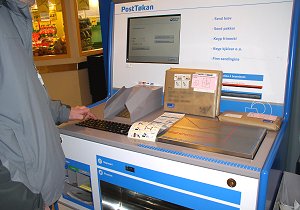 |
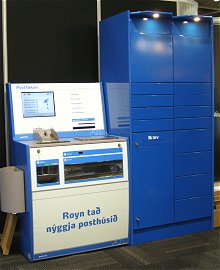 |
Postal customers can use these postal kiosks for the franking of postal pieces and also to buy stamps, but they can also use the kiosks for the purchase of packing and shipping products, and in future for the delivery and collection of postal packets, connecting the self-service machine to a parcel station: An interesting application for one of the latest products launched by aCon.
Parcel stations have been developed in recent years by some companies, and are already in service in many countries around the world. |
| Postal kiosk and parcel station for the Faroe Islands. Installation for demonstration at Post-Expo 2008. |
Taking advantage of the installation of the postal kiosk, the Faroe philatelic service produced the first series of self-adhesive labels, and has announced new issues annually.
| The labels have the same characteristics as those manufactured for Post Danmark for their aCon machines. They are also manufactured by the Danish company Ganket A/S on thermal paper and sized 55.00 x 22.50 mm., with a perforation 11 1/4 (horizontal) and 11 1/2 (vertical) on 3 sides around the design. At the right there is an area, with a straight edge, that is used for the printing of the face value and the 11-digits control code. |
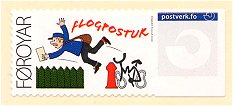 |
Unlike the Danish labels, the Faroe labels do not have any phosphorescent coating. They are on rolls of waxed backing paper 60 mm wide, with a distance of 6 mm. between labels and horizontal serrations.
The Faroe philatelic service has 2 aCon stamp printers, one of which is used for the issue of ATMs for philatelic orders. The minimum face value supplied is 6 DKK, corresponding to the inland mail rate at the date of issue.
Moreover, it is also possible to obtain these issues at the aCon postal kiosk installed in the Postverk Føroya main post office in Tórshavn, from a minimum face value of 0.25 DKK. And as in the Danish case, this results in the existence of two printing varieties, depending on the origin of the stamps.
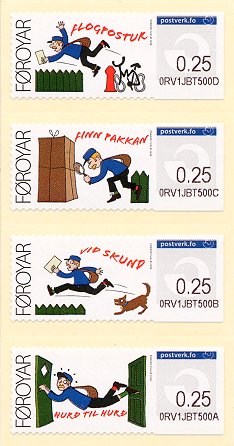 |
 |
The first issue is make up for a series of 4 funny designs by the Faroese artist Edward Fuglø, related to the post. The texts are in Faroese.
Flogpostur: Airmail.
Finn pakkan: Find the parcel.
Við skund: Express mail.
Hurð til hurð: Door to door. |
FDCs
void
| The basic postal tariffs in Faroe Islands (2008 - ...) |
Standard letters
up to 50 g. |
Faroe
Islands |
Iceland |
Europe and
Nordic countries |
Rest of the
world |
| |
A
priority |
A
priority |
B
economique |
A
priority |
B
economique |
| 9.10.2008 |
6 DKK |
8 DKK |
10 DKK |
8 DKK |
12 DKK |
10 DKK |
The currency of the Faroe Islands is the Faroese kroner, although is not an independent currency, but a special issue of the Danish kroner (DKK).
ATM Web - Spain and Latin American Postal Services: http://www.ateeme.net
© J. Jove - M. Sans. ATEEME. Variable value stamps study group. All rights reserved
This page was created in 2002 and last updated:
12.01.09
. English edition rewritten by S. Goodman (xx.01.2009)
|






